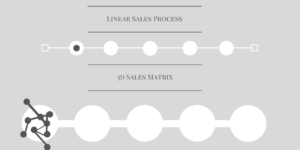 I got my start in the sales world as a representative for Cutco Cutlery. It was a direct, in-home sales gig. The only challenge: I had never had a formal sales job before. And I wasn’t the only one in the situation. Of the thousands of college students that work with the company every year, most don’t have any sales experience. Heck, for many it’s their first job.
I got my start in the sales world as a representative for Cutco Cutlery. It was a direct, in-home sales gig. The only challenge: I had never had a formal sales job before. And I wasn’t the only one in the situation. Of the thousands of college students that work with the company every year, most don’t have any sales experience. Heck, for many it’s their first job.
The way that the company became one of the top cutlery companies in North America was by teaching a simple, step-by-step sales process to all of these rookies. It had 7 steps and it was gospel for us, starting with “Number 1 – Building Rapport” and finishing with “Number 7 – Asking for the Order”.
And it worked! It allowed inexperienced sales reps to connect with their customers, build value, present options, handle objections, and close sales. The sales process was simple because the sales situation was relatively simple. It was a one-call close with a relatively straightforward product and a single decision-maker. (Although it could be a little challenging if Mr. and Mrs. Jones weren’t on the same page).
Finding Sales Success in the Non-Linear World
If your sales process is as linear as the Cutco process, you can keep doing business the way you’ve always done it. But my guess is you are seeing two issues complicate your sales relationships:
- Simple tasks (and jobs) are being mechanized: If your sales engagement is simple and linear, it can be performed by technology in a more consistent and efficient (i.e. cost-effective manner). The “person” part of salesperson can be removed.
- Prospects have more information available and more complicated decision-making processes: Sales roles are rarely as basic as selling a simple offering to one person and being the only provider of information to that one person.
I call the new sales environment the Sales Matrix™. Instead of being a linear process, the Sales Matrix is a 3D cloud of relationships between the salesperson, the prospect(s), and the people and information that influences them. All of these connections need to be managed during the sales engagement. And it’s rarely a simple, step-by-step process.
That doesn’t mean that you should just give up any structure and hope that things go well. There is still a forward flow in the sales conversation. But there aren’t necessarily simple steps that you can check off of a list. Instead there are major “beats” that you need to hit before you can move forward.
The Base Camps in the Sales Matrix™
 Think of these different beats as waypoints or base camps up the side of the mountain. Each one is a mini-goal that is a part of the on-going conversation. For example, until you’ve established trust and rapport, you can’t dive into the prospect’s challenges. Likewise, you can’t move towards an agreement if the prospect hasn’t bought into how your solution solves their problem.
Think of these different beats as waypoints or base camps up the side of the mountain. Each one is a mini-goal that is a part of the on-going conversation. For example, until you’ve established trust and rapport, you can’t dive into the prospect’s challenges. Likewise, you can’t move towards an agreement if the prospect hasn’t bought into how your solution solves their problem.
So there is still forward momentum, but there are a lot of different ways to hit each of these beats. Your job as a sales professional is to identify how to make these happen in the relationship. Situational awareness is critical because you have to understand who all of the players are and how and what to communicate with them. Then you have to execute on that knowledge.
And you have to be aware that you could go backward or forward in the conversation at any time. You might think that you’ve established your credibility and your offerings effectiveness, but then your primary contact gets a new boss who has different priorities. Or you might jump ahead if the prospect gets an accelerated timeline. You are always reassessing and reestablishing.
The 6 Steps of the Sales Matrix
As you read through this list, you’ll notice that nothing here is revolutionary. It closely follows the linear sales process – because we are still trying to sell! The same needs have to be met when working with prospects. It looks like:

The difference lies in the fact that these aren’t discrete points in the process, but rather nodes that have a bunch of variables and connections within them. When you are navigating your sales relationships, here are the 6 base camps you need to pass through to reach your goal.
1. Establish Trust
Trust has always been a critical piece of the sales process. It’s the basis for everything follows. If you don’t have trust built from the very beginning, you’re going to run into problems. If you can’t get someone to believe you, the rest of your conversation is built on a foundation of sand.
The idea of building rapport and connection is often given short shrift, which is ironic. No matter how much time you spend honing the rest of your sales conversations, if you can’t build a relationship, it doesn’t matter. This starts well before actually engaging with prospects, because not only can prospects research possible solutions, they can research you. Instead of having to extend provisional trust, people can use a simple Google search to find out all about the person that wants to sell to them. Spend time developing a clear and relevant brand online, and make sure that carries through to your offline conversations.
2. Understand their Problems from Their Perspective
 When you walk into a sales conversation, you are rarely starting from scratch. The research shows that buyers are completing over half of their process before they ever engage with a sales person, so a lot has already happened. You have to plug into this and move it along. If you can’t make their decision-making better, faster, or more efficient, they don’t need you.
When you walk into a sales conversation, you are rarely starting from scratch. The research shows that buyers are completing over half of their process before they ever engage with a sales person, so a lot has already happened. You have to plug into this and move it along. If you can’t make their decision-making better, faster, or more efficient, they don’t need you.
Do as much research as you can before you engage with your prospect. Then, when you do start the conversation, resist the temptation to immediately dive into what you want to share. Ask as many questions as possible to understand the prospect’s decision-making process, environment, needs, fears, and challenges. Most sales processes have a “discovery” portion. Not only should you spend as much time as possible here, you should also know that their challenges and needs will continue to evolve.
3. Connect Their Problems and Your Solutions
At a certain point, you will have a very clear idea of what your prospect needs and how you can solve that problem. Now it’s time to connect these two pieces of the puzzle. In the old parlance, this would fall under the category of “building value”. But we’re not building value in isolation by talking about what we can do. Rather, value is built intentionally by connecting our solutions to their needs.
This is the natural extension of the old “features vs benefits” distinction. They don’t care what your product or service does, they care how it cures their pain. Understand that this might require connecting different aspects of your solutions to different problems that different people have. For example, if the end-user is different than the financial decision-maker, you will have to solve both of their challenges – probably by highlighting different parts of your solution.
4. Get Buy-In
 When many people thinking of selling, they think of the back and forth negotiating and cajoling. This usually comes after the salesperson has asked for the business and the prospects haven’t said yes…or no. As this point, the salesperson is handling objections and trying to move things forward.
When many people thinking of selling, they think of the back and forth negotiating and cajoling. This usually comes after the salesperson has asked for the business and the prospects haven’t said yes…or no. As this point, the salesperson is handling objections and trying to move things forward.
But in the Sales Matrix, this happens first. You can think of this as a process that involves a lot of what are called “trial closes”. This is a nice way of describing the questions that you would ask throughout the process to rope the prospect in. But in the Sales Matrix, you aren’t trying gimmicks for the heck of it. Instead, you are continually getting everybody on the same page and keeping them there. By going slower, you are ensuring that you have agreement along the way. And if you don’t, you aren’t wasting time and energy.
5. Ask for the Next Step
Just because there isn’t a clear “closing question” in the Sales Matrix, that doesn’t mean that there isn’t a point where you have to ask for the business. At some point, you have to ask, “Are we going to work together?”
One of the key differences is that you should know the answer to the question before you ask it. It won’t always be the case, but if you’ve done everything well up to this point, you should have a pretty good idea of what the answer is going to be. Because the process is more relational, you’ll have more opportunities to uncover potential roadblocks and to get the incremental agreements. This is the pivot point where they go from prospect to customer.
6. Continue to Build the Relationship
 Once you have closed the deal, the relationship isn’t going to suddenly stop. In a transactional sales process, the sales person gets the sales, passes it on to whomever is going to execute the business, and moves on. But with the higher degree of time and effort spent building the relationship, it doesn’t make sense to jump to the next deal and abandon the customer.
Once you have closed the deal, the relationship isn’t going to suddenly stop. In a transactional sales process, the sales person gets the sales, passes it on to whomever is going to execute the business, and moves on. But with the higher degree of time and effort spent building the relationship, it doesn’t make sense to jump to the next deal and abandon the customer.
While you don’t have to become a customer’s best friend, there are a lot of benefits to continuing to cultivate the relationship. From a business-delivery standpoint, the salesperson is poised to solve any bumps that occur during execution. They’ve built the trust that can help things flow much more smoothly. And they can further leverage that relationship by getting referrals, testimonials, and feedback from their customers. This is where the savvy sales professional can move their customers to champions.
